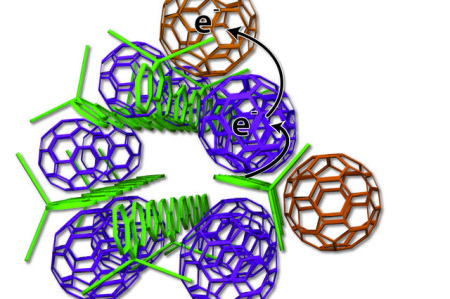Jun
23
Store Solar Energy Without a Battery or Capacitor
June 23, 2015 | Leave a Comment
UCLA chemists are developing photovoltaic cells that store the electrical energy. The work is a major improvement for capturing and retaining energy from sunlight, where the stored energy can last dramatically longer than current solar technology allows. The storage can last up to several weeks, instead of the microseconds found in today’s rooftop solar panels.
The team’s study paper has been published in the journal Science.
Sarah Tolbert, a UCLA professor of chemistry and one of the senior authors of the research starts off the explanation. The new design is inspired by the way that plants generate energy through photosynthesis. “Biology does a very good job of creating energy from sunlight. Plants do this through photosynthesis with extremely high efficiency,” she said.
“In photosynthesis, plants that are exposed to sunlight use carefully organized nanoscale structures within their cells to rapidly separate charges – pulling electrons away from the positively charged molecule that is left behind, and keeping positive and negative charges separate,” Tolbert said. “That separation is the key to making the process so efficient.”
To capture energy from sunlight, conventional rooftop solar cells use silicon, a fairly expensive material. There is currently a big push to make lower-cost solar cells using plastics, rather than silicon, but today’s plastic solar cells are relatively inefficient, in large part because the separated positive and negative electric charges often recombine before they can become electrical energy.

Energy Saving Nanonscale Polymer and Fullerine Structure. The solar cell ingredients, with bundles of polymer donors (green rods) and neatly organized fullerene acceptors (purple, tan). Click image for the largest view.
“Modern plastic solar cells don’t have well-defined structures like plants do because we never knew how to make them before,” Tolbert said. “But this new system pulls charges apart and keeps them separated for days, or even weeks. Once you make the right structure, you can vastly improve the retention of energy.”
The two components that make the UCLA-developed system work are a polymer donor and a nano-scale fullerene acceptor. The polymer donor absorbs sunlight and passes electrons to the fullerene acceptor; the process generates electrical energy.
The plastic materials, called organic photovoltaics, are typically organized like a plate of cooked pasta – a disorganized mass of long, skinny polymer ‘spaghetti’ with random fullerene ‘meatballs.’ But this arrangement makes it difficult to get current out of the cell because the electrons sometimes hop back to the polymer spaghetti and are lost taking the energy potential with them.
The UCLA team’s technology arranges the elements more neatly – like small bundles of uncooked spaghetti with precisely placed meatballs. Some fullerene meatballs are designed to sit inside the spaghetti bundles, but others are forced to stay on the outside The fullerenes inside the structure take electrons from the polymers and toss them to the outside fullerene, which can effectively keep the electrons away from the polymer for weeks.
Benjamin Schwartz, a UCLA professor of chemistry and another senior co-author explains further, “When the charges never come back together, the system works far better. This is the first time this has been shown using modern synthetic organic photovoltaic materials.”
In the new system, the materials self-assemble just by being placed in close proximity.
Tolbert resumes with, “We worked really hard to design something so we don’t have to work very hard.” The new design is also more environmentally friendly than current technology, because the materials can assemble in water instead of more toxic organic solutions that are widely used today.
Schwartz takes the explanation again with, “Once you make the materials, you can dump them into water and they assemble into the appropriate structure because of the way the materials are designed, there’s no additional work.”
The team is already working on how to incorporate the technology into actual solar cells.
Yves Rubin, a UCLA professor of chemistry and another senior co-author of the study, led the team that created the uniquely designed molecules. “We don’t have these materials in a real device yet; this is all in solution,” he said. “When we can put them together and make a closed circuit, then we will really be somewhere.”
For now, though, the UCLA team has proven that inexpensive photovoltaic materials can be organized in a way that greatly improves their ability to retain energy from sunlight.
Odds are that this technology will get onto a solar cell and soon. Expect it will make a huge difference in overall performance.
Hat tip to one best written press releases in memory!

